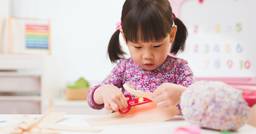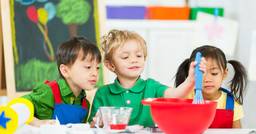How to Use Developmentally Appropriate Practice in Early Childhood Education
*First published June 2023
*Updated January 2025
The first five years of a child’s life are the most crucial years for brain development. Research from the National Association for the Education of Young Children (NAEYC) shows that early experiences play a profound role in shaping how children learn, grow, and interact with the world around them. By age two, a child’s brain is twice as active as an adult’s, forming essential neurological connections that lay the groundwork for future learning and development.
For early educators, these early years present a unique opportunity to spark curiosity, encourage exploration, and foster a lifelong love of learning. Developmentally Appropriate Practice (DAP) provides a proven framework to guide educators in creating meaningful, research-based learning experiences that meet children where they are—cognitively, socially, and emotionally.
In this blog, we’ll break down what DAP means, why it matters in early childhood education (ece), and how educators and child care providers can use it to support all areas of children’s development.
What is Developmentally Appropriate Practice (DAP)?
Before we dive into the how of Developmentally appropriate practice, it is important we have an understanding of what it is and why we use it. Developmentally appropriate practice is an approach to teaching that aligns with high-quality research about how young children learn and what they need during these formative years of development. It considers three key factors:
- Age-appropriate milestones based on child development research.
- Individual differences that make every child unique, including their interests, abilities, and learning styles.
- Cultural and social contexts that shape a child’s experiences and perspectives.
At its heart, DAP is about creating supportive, inclusive, enriching and high-quality learning environments that meet the individual needs of all young children.
Let’s explore how DAP supports each area of early childhood development.
Physical Development: Building Strength and Coordination
Physical development—including gross and fine motor skills—is foundational to a child’s overall growth and ability to navigate the world. Here are a couple developmentally appropriate learning experiences to support young children’s physical growth and learning.
Outdoor Play: Promoting Gross Motor Skills
Daily outdoor play gives children the freedom to move, run, jump, and climb—all essential for building coordination, balance, and strength. Activities like navigating playground equipment or participating in group games encourage physical fitness while supporting focus, decision making, sensory learning and self-regulation. Studies show that outdoor movement enhances both physical health and cognitive performance in young learners.
Fine Motor Skills: Small Movements, Big Impact
Inside the classroom, play-based activities help children develop their fine motor skills. Drawing, building with small blocks, or threading beads strengthens the hand muscles needed for tasks like writing and buttoning shirts. These activities not only support physical milestones but also encourage creativity and problem-solving in individual children.

Cognitive Development: Encouraging Exploration and Problem-Solving
Cognitive development encompasses critical thinking, problem-solving, and the foundations of early literacy and math. Through the application of DAP in early childhood programs, educators create opportunities for hands-on learning and discovery. Here are a few developmentally appropriate practices to support cognitive development in early childhood.
Scaffolding Learning: Individualized Support
Every child learns at their own pace, and the partnerships we build with them must reflect this understanding. Educators can implement scaffolding techniques within learning activities to offer just the right amount of support—challenging children while nurturing their independence. For example, a counting activity can begin with simple concepts and gradually increase in complexity as children gain confidence and skills. This approach ensures learning is tailored to each child’s unique individual needs and growing skills.
Play-Based Learning: Inspiring Curiosity
Play-based experiences encourage exploration and creativity while embedding important cognitive skills. Simple activities like building with blocks, experimenting with sensory bins, or exploring science concepts through hands-on experiments inspire children to ask questions, think critically, test their abilities and make discoveries.
Emotional Development: Fostering Confidence and Resilience
Emotional development involves guiding children to understand and manage their emotions while fostering empathy and resilience. The following developmentally appropriate learning experiences highlight how educators can support the critical development of emotional intelligence.
Self-Regulation and Emotional Expression
Early educators play a key role in teaching children how to express and regulate their emotions constructively. Simple teaching practices like modeling clear communication and offering supportive language can help children identify and work through their feelings.For example, encouraging a frustrated child to express their feelings—whether by describing them verbally, pointing to a relatable emotion on a storyboard, or drawing their emotions depending on their age—can help them process their experiences more effectively.
Building Confidence Through Encouragement
Positive reinforcement and encouragement in any learning program nurture a child’s confidence. Activities like group storytelling or small group role-playing help children develop empathy, work collaboratively, and feel a sense of accomplishment.
Research underscores that emotional well-being in early childhood also contributes to stronger mental health and social relationships later in life.
Language Development: Growing Communication Skills
Language is a key tool for learning and self-expression, making it a vital part of early development and a core consideration for high-quality early education programs. Here are a few ways early childhood educators can support language development from a developmentally appropriate lens.
Conversations and Storytelling
From infancy, engaging children in conversations supports vocabulary growth and verbal skills. Educators can encourage communication through open-ended questions, interactive storytime, and songs. Even simple conversations during snack time or play allow children to express their thoughts and ideas.
For more resources on early education and best practices, explore our collection of blogs and resources tailored to educators and parents alike.
Maddie is a Registered Early Childhood Educator with a Master's in Early Childhood Studies. Her specialty is in Children's Rights and she is currently a Content Strategist for HiMama!
More by Maddie




